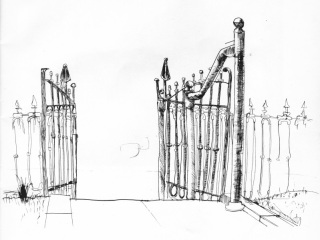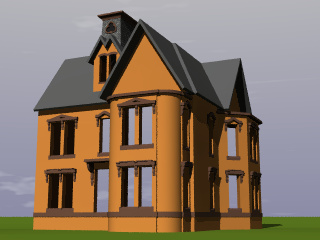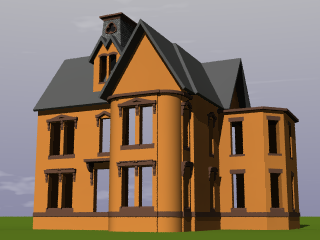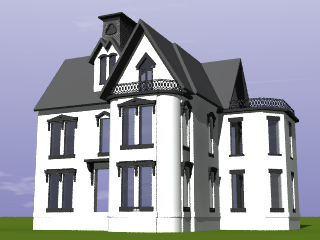The Mysterious History of 1221 Massachusetts Avenue N.W.
by Dana Sawyer
Introduction
There has been much conjecture about the history of 1221 before it
became the home of our school, but little documentation.
Thanks to computer indexing of records and the increasing availability
of archival material on the web, as well as a visit to the Library of Congress, I've begun to piece together the story.
Prehistory
It may be possible to determine the architect and date of construction
of 1221 if the original building permit has been preserved. Washington building records in the National Archives may provide the answer, and early street directories will probably reveal the original owner.
My guess is that 1221 was built around 1875, but for now the story begins in 1888.
1888: An unfortunate dog

|
What may
be the earliest appearance of 1221 Massachusetts Avenue in the Washington Post
archives is on October 30, 1888, when a dog was injured on the iron
fence in front of the property.
(This was probably the same fence that was there in our day.
David Pariser drew the picture at left, which appeared in the 1964
yearbook, but the dog was gone by that time. Click on the picture for a larger image.)
From ground plans in the 1888 and 1903 editions of the Sanborn Insurance Maps of Washington, D.C.,
the general layout of the building in that era can be reconstructed as
shown at left below. However, the type and placement of windows
on the east bay is conjectural, and the picture omits dormers,
railings, and some other details.
|
1893: An eccentric millionaire

From at least the fall of 1893, there are various mentions in the news
that Dr. Leroy M. Taylor, Confederate veteran, world traveler, and
"Washington's most eccentric millionaire" was living at 1221
Massachusetts avenue northwest, as the address was then written.
Dr. Taylor and wife Rose Utermehle Taylor together with their son,
Leroy Jr., continued to live there until 1901. In early 1901,
shortly after the death of Rose
Taylor, Dr. Taylor and his son gained a lot of unwelcome publicity
because of a fierce legal dispute over the estates of Mrs. Taylor and
her
father. Had the suit gone against him, Dr. Taylor could have lost
most of his fortune, including "the valuable property at 1221
Massachusetts avenue", which his wife had allegedly bought with funds
from the contested estate.
After the death of his wife, Dr. Taylor withdrew from society. He
constructed an unusual fireproof building in a poor neighborhood at
1133 Brown Court, N.W. and moved there some time in 1901. The
very stark exterior had the appearance of a warehouse, and even had
"Taylor's Storage" painted on the side, but the interior contained his
extensive library of rare books and much of his elegant furniture from 1221.
Dr. Taylor died in September, 1904, and was buried with honors
befitting a Scottish Rite Mason of the highest degree. His final
residence was later described as a "fortified castle" or even a
"palace", "furnished with all the luxury money could buy", though few
people saw its interior during his lifetime. Clearly 1221 had
been furnished as luxuriously while he resided there;
perhaps the great mirror in the hallway (now preserved at the Sumner
School building) is the last trace of that luxury.
Some hint of the original furnishings of 1221, apart from those
which Dr. Taylor took to Brown Court, is given by an auction notice
which appeared in the
Washington Post in late 1901 for the
estate of Mrs. Taylor. The sale included "forty-five pairs of costly
lace curtains" -- enough for every window in 1221 as it then existed --
as well as "fine tapestries, draperies, embroideries, cushions,
hand-painted and embroidered screens, gilt cabinets, chairs, tables,
rare bric-a-brac, paintings, curios, water colors, etchings, cut glass,
&c."
It's interesting to try to imagine 1221 in Dr. Taylor's day. The
exterior would have been smooth unpainted yellow pressed brick, probably with brownstone
sills and lintels, and gold numbers on the transom announcing the address. The interior woodwork would have been
unpainted as well, as some of it still was in our day. In the
evening, gas lamps hissed their greenish light through
crystal shades, as guests glided silently from room to room over deep
carpets, glittering past the mirror to the sound of an unseen grand piano. Guests then, ghosts now; gone.
1908: The Epiphany Church Home

The Church of the Epiphany is one of the few remaining pre-Civil
War church
buildings in Washington, located at 1317 G. Street N.W. At
least as far back as the 1870s, the church had established the
Epiphany Church Home for Women at 1319 H Street nearby, and in 1908
they purchased the Massachusetts Avenue property for $27,000 and
moved the Church Home there. In 1909 they demolished a stable and
carriage houses which adjoined the alley and built a
"new addition" at the rear of 1221 (not shown in picture at left), which was ready for occupancy in
November of that year. This was comprised of small individual
rooms for
the residents, all of whom apart from the matron and staff were elderly
women. The dining room,
later known to us as the OSH (Old Study Hall), was probably
enlarged at that time, as well as the room above it, which may then
have served as the
infirmary. The single large wooden side porch appears to have replaced
originally separate side and rear porches.
The chapel furnishings and stained glass windows were donated in 1910
by two generous
parishioners as a memorial to their aunt, Sarah Coleman, bringing the
total spent on the building, addition, and chapel to $62,300.
Initially
the building remained quite elegant, but at some later time
stark black and white paint covered the earthy tones of yellow brick
and
brownstone, and linoleum tiles replaced carpets
inside.
The residents seem to have led a genteel existence, becoming visible
from time to time on the society pages or the obituary pages, the latter
sometimes as a result of unfortunate
pedestrian encounters with busy Washington traffic. Meanwhile
another similar institution, the Episcopal Church Home, was established
in 1924 on Wisconsin Avenue, but the two facilities continued separate
existences within the same denomination.
In 1957, a new building for the Episcopal Church Home was constructed
"in a park-like Georgetown setting" on the grounds of the Bowie mansion
at 3124 Q. Street, N.W. When it was complete, the Epiphany Church
Home residents and chapel furnishings were consolidated into the larger facility, and on January 15, 1958, 1221 became
available for new adventures.
Possibly the most famous resident of the Epiphany Church Home was
Rosalie Mackenzie Poe, who died there in 1874 when it was located on H Street; she was the only sister
of Edgar Allan Poe.
1958: A School
 |
For the 1958-1959 school year, Hawthorne moved to a new site from its original
basement at 1914 N. Street N.W. As Robin Kraus related in the
1960 yearbook:
The new building for the school was located at 1221
Massachusetts Ave., N.W. It was once a very fine town house and,
more recently, an old ladies home. After the old ladies moved
out, and the youngsters entered, the D.C. government decided that a
whole new set of fire regulations were necessary, much stricter than
those for the former elderly occupants! These were added, and
after painting and washing by students themselves, the school was ready
for occupancy.
At the last moment, the three rooms in the back were made into one -- Dante's art room.
|
Actually, new fire regulations were one of the factors
which forced the Church Home to close; for a number of years, the D.C.
government only allowed it to operate at half capacity, leading to a
major operating deficit. But the three story exterior fire stairs
on the west side of the building were added by the school in the fall
of 1962 along with other safety improvements. Even so, the front
part of the third floor was cordoned off by a heavy fire door and
remained off-limits to students except by special permission, though it
contained Howie's dulcimer shop and a work area for the librarian.
In the early days, Howie Mitchell lived on the third floor for a
time, and John O'Hara remembers sneaking into the school one night to
show the place to his girlfriend, only to be confronted by Howie, who
was holding a gun!
The consolidation of small rooms in the 1909 addition continued for several years, creating
an assembly room, a library, and several medium-sized classrooms on three floors. A few of the
small rooms remained, such as the ones where Mr. Howison
taught Latin to his faithful band of scholars and Señorita
Gonzalez taught advanced Spanish to hers.
More about the Hawthorne years at 1221 can be found elsewhere on this site, including the history from the 1961 yearbook, photographs, and newspaper clippings.
Eventually, Hawthorne made the move to southwest Washington, and 1221
was demolished in the summer of 1964. Apart from a few bricks, only the mirror remains.
But those of us who were there will never forget the place, and now there is virtual 1221.
Bibliography
Church of the Epiphany web site at
http://www.epiphanydc.org/.
Epiphany: Church and Parish, 1842-1972, by Stetson Conn
(Epiphany Church, 1976). I have drawn most of the history of
Epiphany Church Home from this interesting book, and most of the rest
from
Washington Post articles.
"Episcopal Senior Ministries: History of Service" at
http://www.esm.org/history.htm.
Episcopal Senior Ministries is the present successor to the Episcopal
Church Home. Currently they run several retirement communities in
the vicinity of Washington.
Guide to Resources for Researching Historic Buildings in Washington, D.C.,
by Kim Hoagland (Don't Tear It Down and the Columbia Historical
Society, 1981). Although it is somewhat out of date, it contains
a great deal of useful information on researching historic
buildings. The Columbia Historical Society museum has now become
the City Museum of Washington, which is a major resource for Washington
history.
Insurance Maps of Washington D.C., published by Sanborn Map
Company. I was able to view and
photograph the 1888, 1903,
1928, and 1981 editions in the map room of the Library of Congress; all
except the last show the general plan of the original building at 1221
and its various outbuildings or later additions. One of the
copies of the 1928 atlas at Library of Congress has a pasted-in update
c. 1960 in which 1221 is labeled "School (priv.)" rather than "Epiphany
Church Home". (Since the update doesn't show the second fire
escape added by the school it must be prior to 1963.) Other Washington
area libraries have varied holdings of Sanborn and other insurance or
real estate atlases. These atlases usually show the shape and
height in stories of each
building and sometimes its
roof configuration, with notes on the types of materials used and other
features of interest to insurers.
"Interments in the Historic Congressional Cemetery" available at
http://www.congressionalcemetery.org/PDF/Obits/T/Obits_Taylor.pdf. This
contains the obituary for Sabrina A. Taylor (died 14 November 1882),
mother of Dr. Leroy M. Taylor. Dr. Taylor was then residing at 401 M street
northwest.
The Scarlet Letter 1960 (first ever Hawthorne yearbook).
John O'Hara convinced me that Hawthorne really was at 1221 in
1958-1959, and a careful reading of Robin Kraus's article confirms it.
The Scarlet Letter 1961 (second Hawthorne yearbook). This contains an excellent
summary of the school's history which confirms that the school moved to 1221 in 1958. In an unusually poetic
valedictory,
Shirley Stickney expressed her love of the building, the school, and
her classmates, and her hope that we can all retain a childlike
imagination and a sense of wonder.
U.S. Supreme Court, UTERMEHLE v. NORMENT, 197 U.S. 40 (1905), available at
http://laws.lp.findlaw.com/getcase/us/197/40.html. This was the final decision upholding the will of Leroy Taylor's father in law, George W. Utermehle.
Washington Post article abstracts (most relevant of those consulted) and articles:
"A Dog Impaled on a Fence", Oct 30, 1888, p. 2. Nothing about
the house at 1221 or its owner in this brief article. The Sanborn
Insurance Atlas for 1888 confirms that the house existed at that
date -- and even had a window in its west third floor gable end, though
this was covered sometime prior to 1903 when the adjoining building at
1229 was replaced with a more substantial one.
"BIDDING DR. TAYLOR FAREWELL:Previous to His Departure to the
Sandwich Islands", Sept 28, 1893, p. 2. This article is the
earliest mention in the Post of Dr. Taylor residing at 1221 Massachusetts Avenue.
"THEFT OF CLOTHING TRACED.:Servant of Leroy Taylor, Jr., Accused of Taking it from Her Employer", Aug 18, 1898, p. 10.
"NEW MOVE IN UTERMEHLE FIGHT.:Receiver Asked for Mrs. Taylor's
Estate Pending Outcome of Caveat Proceedings" Feb 8, 1901, p. 2.
Establishes the date of Mrs. Utermehle's death as 1/22/1901, and
summarizes the accusations in the lawsuit.
"Important Sale"
"DEATH OF DR. LEROY TAYLOR: Confederate Veteran and Traveler Vic-tem
of Bright's Disease", Sept. 28, 1904. Contains some interesting
biographical details.
"PALACE IN AN ALLEY:Strange Abode of the Late Dr. Leroy M. Taylor.
LIVED THERE LIKE A PRINCE Surrounded by Stables and Negro Shanties and
with an Exterior of Forbidding Aspect, Dr. Taylor's Home Was Furnished
with All the Luxury Money Could Buy -- Protected Like a Fortress", Oct
25, 1904, p. 2. The headline says it all, but the lengthy story,
though unfortunately not very legible in PDF format, contains some
interesting details about Dr. Taylor and his possessions.
"UTERMEHLE WILL SUSTAINED.:End of Contest Involving Property Valued
at $1,600,000.", Feb 21, 1905. After years of litigation,
and months after the death of Dr. Taylor, the will was finally upheld (see Supreme Court decision cited above).
"EPIPHANY CHUKCH(sic) HOME.:New Addition Will Be Ready for Occupancy
This Week", Nov 14, 1909, p. CA6. The typo is only in the online
abstract. The article has the earliest picture I've found
so far of the building (amazingly unchanged in the 1960's except for
the colors), and other interesting information.
"Poe's Sister Buried In Unmarked Grave", Oct 21, 1933, p. 10.
She was buried in Rock Creek Cemetery, in a section belonging to the
Epiphany Church Home.
"Episcopal Home Plans Restoration", Jul 8, 1956, p. F10.
Announced that the Epiphany Church Home would be combined with the
Episcopal Church Home. The new facility was attached to the Bowie
Mansion in Georgetown, built in 1800.
"Bowie Mansion Serving Church", February 9, 1957. A follow-up
article on the Georgetown facility combining the Epiphany Church Home with the
Episcopal Church Home.
More resources to explore
Recently,
The Washington Post
has
put abstracts of their articles back to 1877 on line with full text
search, opening an
interesting window on late 19th century Washington, including an
occasional peek at 1221.
Unfortunately, the cost of the full texts of the articles (considering
the number of relevant items) makes it impractical to
buy every article of possible interest, though I have purchased
some carefully selected ones and gathered other useful information from
the abstracts as listed above. (Some libraries offer free
access to the Washington Post archives.)
The
Washington
Star online archives for 1852 to 1890 are available from
Paper of Record;
there are no free abstracts, but monthly or yearly subscriptions offer
unlimited article retrievals from digitized microfilm. References to Dr. Taylor in the
Star are mainly reports of his Masonic activities, and there is little or nothing about 1221.
Other
archival sources may be available in the D.C. Public Library's Washingtoniana collection, the City Museum of Washington, various
archives of the D.C. government, various Episcopal Church archives, the National Archives, the Library of Congress and the
Smithsonian.
Although most archives will do research and copy materials for a fee,
it is useful to be able to visit them in person. If anyone in the
D.C. area would like to assist in this research, please
contact me.
The Library of Congress staff were very helpful during my visit there
in April 2004, as seems generally to be the case with research
libraries.
Last updated February 10, 2006

 From at least the fall of 1893, there are various mentions in the news
that Dr. Leroy M. Taylor, Confederate veteran, world traveler, and
"Washington's most eccentric millionaire" was living at 1221
Massachusetts avenue northwest, as the address was then written.
Dr. Taylor and wife Rose Utermehle Taylor together with their son,
Leroy Jr., continued to live there until 1901. In early 1901,
shortly after the death of Rose
Taylor, Dr. Taylor and his son gained a lot of unwelcome publicity
because of a fierce legal dispute over the estates of Mrs. Taylor and
her
father. Had the suit gone against him, Dr. Taylor could have lost
most of his fortune, including "the valuable property at 1221
Massachusetts avenue", which his wife had allegedly bought with funds
from the contested estate.
From at least the fall of 1893, there are various mentions in the news
that Dr. Leroy M. Taylor, Confederate veteran, world traveler, and
"Washington's most eccentric millionaire" was living at 1221
Massachusetts avenue northwest, as the address was then written.
Dr. Taylor and wife Rose Utermehle Taylor together with their son,
Leroy Jr., continued to live there until 1901. In early 1901,
shortly after the death of Rose
Taylor, Dr. Taylor and his son gained a lot of unwelcome publicity
because of a fierce legal dispute over the estates of Mrs. Taylor and
her
father. Had the suit gone against him, Dr. Taylor could have lost
most of his fortune, including "the valuable property at 1221
Massachusetts avenue", which his wife had allegedly bought with funds
from the contested estate. The Church of the Epiphany is one of the few remaining pre-Civil
War church
buildings in Washington, located at 1317 G. Street N.W. At
least as far back as the 1870s, the church had established the
Epiphany Church Home for Women at 1319 H Street nearby, and in 1908
they purchased the Massachusetts Avenue property for $27,000 and
moved the Church Home there. In 1909 they demolished a stable and
carriage houses which adjoined the alley and built a
"new addition" at the rear of 1221 (not shown in picture at left), which was ready for occupancy in
November of that year. This was comprised of small individual
rooms for
the residents, all of whom apart from the matron and staff were elderly
women. The dining room,
later known to us as the OSH (Old Study Hall), was probably
enlarged at that time, as well as the room above it, which may then
have served as the
infirmary. The single large wooden side porch appears to have replaced
originally separate side and rear porches.
The Church of the Epiphany is one of the few remaining pre-Civil
War church
buildings in Washington, located at 1317 G. Street N.W. At
least as far back as the 1870s, the church had established the
Epiphany Church Home for Women at 1319 H Street nearby, and in 1908
they purchased the Massachusetts Avenue property for $27,000 and
moved the Church Home there. In 1909 they demolished a stable and
carriage houses which adjoined the alley and built a
"new addition" at the rear of 1221 (not shown in picture at left), which was ready for occupancy in
November of that year. This was comprised of small individual
rooms for
the residents, all of whom apart from the matron and staff were elderly
women. The dining room,
later known to us as the OSH (Old Study Hall), was probably
enlarged at that time, as well as the room above it, which may then
have served as the
infirmary. The single large wooden side porch appears to have replaced
originally separate side and rear porches.